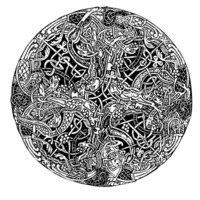Plant Forms
Dublin Core
Title
Plant Forms
Description
The reference to the plant forms which rarely occur in the Book of Kells and not at all in the Book of Durrow and Lindisfarne, have been used to prove that the two latter books belong to an earlier period. It is the author’s opinion (George Bain), based upon many evidences, that the Book of Lindisfarne is later than the Book of Kells. Foliated ornaments entered Southern Britain with the Roman invasions, and forms of Gothic foliage came with the invaders after the fall of Rome, but they differ from those of the Pictish Stones of East Scotland and those of the Book of Kells. In the portions of that book that have been available to the author for research, namely the “studio” publication in colours, of some of its most important pages, and “Celtic Illuminative Art” in black and white, by Rev. Stanford F.H. Robinson, M.A., the examples, with one exception, emerge from pots or beakers. The extreme minuteness of these examples make it probable that the pots have not been noticed and no known mention of them has hitherto been made. Without any possible doubt, this is a pagan and, later, a Christian symbol and its use was a religious one and not merely decorative. - George Bain, Celtic Art, the Method of Construction.
Creator
Vector image created from George Bain book, Celtic Art.
Citation
Vector image created from George Bain book, Celtic Art., “Plant Forms,” Open Virtual Worlds, accessed December 22, 2025, http://straylight.cs.st-andrews.ac.uk/omeka/items/show/396.
Embed
Copy the code below into your web page
